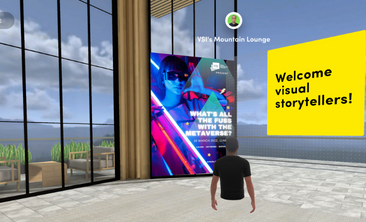
How to transform stories using emerging visual media?
How to transform stories using emerging visual media? https://www.visualstorytell.com/wp-content/uploads/2019/01/immersive_thumb.jpg 370 218 Rafael Baldwin Rafael Baldwin https://secure.gravatar.com/avatar/d9430b2a9d23b8533d4ed8e3603dcafa3c07addf6339303b2482a35379dcff60?s=96&d=mm&r=g- Rafael Baldwin
- no comments
Stories have always served as robust communication tools from ancient times to this day. What’s interesting, is that the story structure remains constant, but what changes are the media through which stories are told. From the time people gathered around the campfire and that’s how legends were passed from one generation to the other.
Today, we have a wide range of visual media platforms from images, video, AR and VR to tell stories and engage our audiences. Yet, adapting the story to your platform culture, buyer persona, and their stage in the buyer’s journey – are still essential steps in producing memorable customer experiences.
The last decade has presented us with technologies and platforms that have reinvented consumer behaviors and demanded communication strategies that understand the use, potential, and trends of these new tools – from Social Media to music streaming services, from Virtual Reality to mobile apps. However, hardware and communication models are being conceived, developed, tested, popularized, and sometimes even phase out, in the blink of an eye.
This year will be a crucial one for many of the companies behind these promising technologies, in which they will aim to democratize their products in order to survive. If you want to remain at the forefront of storytelling innovation, I recommend that you keep an eye on these 3 Immersive Storytelling trends in 2019:
Interactive Video
This new form of content is finally building a much-needed bridge between filmmaking and video games. While television’s viewership ratings are declining, and film exhibitors facing challenges to keep bringing people into the movie theaters, the gaming industry has already more than doubled their annual revenue, which is more than Hollywood and the music industry combined.
Interactive video such as Bandersnatch, the latest Black Mirror’s TV episode published last December on Netflix, is a perfect example of this. This type of interactive video experience aims to bring together the freedom of choice offered by a video game, and the narrative experience of film and TV that people already love.
With interactive video, you are basically watching a movie that at different points in the story prompts you with the question “what do you want to watch next?”. This remarkable technological achievement – is not a small feat to render and buffer all these fragments of video to be ready for you at any given moment – is providing an even more exciting opportunity for storytellers to put their audiences at the center of their stories, and develop stronger affiliation bonds with them.
With media giants such as Netflix behind this new type of content and thousands of brands being eager to find ways of reaching their audiences wherever they might be, you can expect interactive video to gain considerable traction in the months to come. If you haven’t experienced it yet, get your phone, launch Netflix and enjoy Bandersnatch – it is so much fun!
Watch my video recording on the Visual Storytelling Today show:
Micro-influencers
It no longer matters if a former YouTube star still has 15 million followers on his counter, but only a few thousands keep engaging with his content in 2019. The Social Media popularity has proven to change so quickly that the main KPI’s of Facebook and YouTube no longer focus on fan base numbers, but on true daily engagement.
The era of micro-influencers is on the rise, and the best thing is that you no longer need a massive budget to make use of it. An emerging comedian, an indie band, a nonprofit, or a startup, can benefit as much from partnering with the local people who are already deeply engaged with the niche audience that they are trying to reach, as from spreading out the word of what they do through a celebrity influencer.
Why would you bother wasting large sums of money on reaching millions of eyeballs across the country, when your upcoming gig only needs a few, but very specific, hundreds of clients to make it a success.
If you are trying to offer your services, launch a new product, or talk to a new audience, go online and find those micro-influencers who are already engaging with your intended audience, and that could put you right in front of them.
On the road?
You can also listen to my audio podcast of this episode.
Subscribe to the Visual Storytelling Today podcast on iTunes or Google Play
Virtual Reality
VR has been around for many years, but until now, it was expensive and somewhat clunky. The two leading companies in this field, Oculus and HTC Vive, are now paving the way to a new era of Virtual Reality, where devices are starting to offer experiences of extraordinary quality, without breaking your wallet.
These two corporations announced recently that their first prosumer devices – the Oculus Quest and the HTC Vive Cosmos – will reach the market in 2019, at a fraction of the cost of their products for professional use.
The most exciting aspect of Virtual Reality lies not in its technological accomplishments – which are many – but in its ability to provide a convincing immersive experience to its users.
With so many industries already benefiting from Virtual Reality – medicine, architecture, space navigation, to mention a few – the moment of VR democratization has finally arrived, with a new breed of storytellers will not only be required but will also be on high demand.
How do you think these trends might fit into your immersive visual storytelling initiatives in 2019?
Ready to start your emerging visual storytelling program?
Schedule a FREE conversation to capture your business requirements in order to fit the right solution to your overall marketing strategy.
Rafael Baldwin
Single, multi-camera, and VR/360° immersive television director and producer working at the intersection of filmmaking, sound and music production, computer programming, and human interaction. I've been responsible for coverage and special transmissions of the BAFTA Awards, Cannes, Venice, Berlin, San Sebastian, Sundance Europe, and London Film Festivals, The Royal Wedding in Britain, the Coronation of King Philip VI of Spain, the London 2012 Olympic and Paralympic Games, and the NFL at Wembley. I directed the award-winning Virtual Reality documentary "Mission: Frost Science" in collaboration with the Frost Science Museum of Miami. I am the Digital Media Storyteller of Michael Tilson Thomas' New World Symphony orchestra of Miami Beach, and Professor of VR/360º Immersive Storytelling for undergraduate and postgraduate students at the University of Miami. I have extensive experience in non-fiction television broadcast – special projects, music shows, sports transmissions, and news coverage – and my work has been featured on media outlets such as ESPN, BBC, Variety Latino, Univision Networks, and Televisa Media Group. I have performed key functions as producer, director, editor, writer, and camera operator, in live and recorded TV.
All stories by: Rafael BaldwinYou might also like
This site uses Akismet to reduce spam. Learn how your comment data is processed.





Leave a Reply